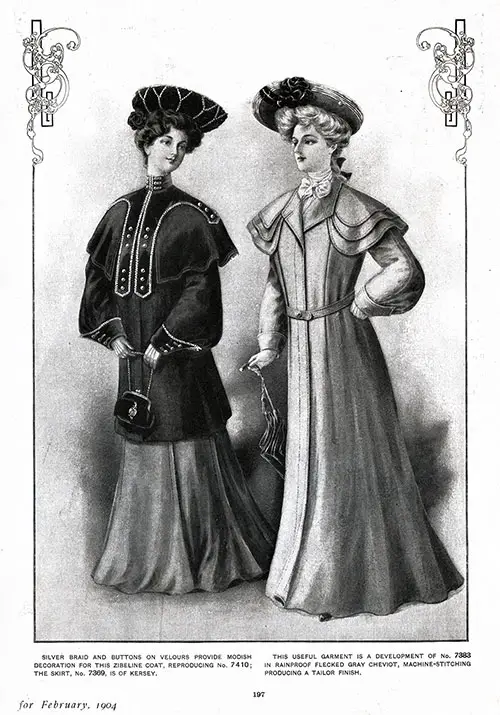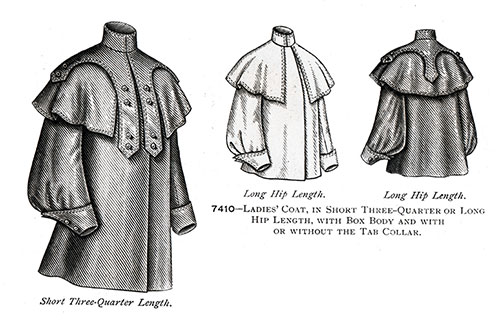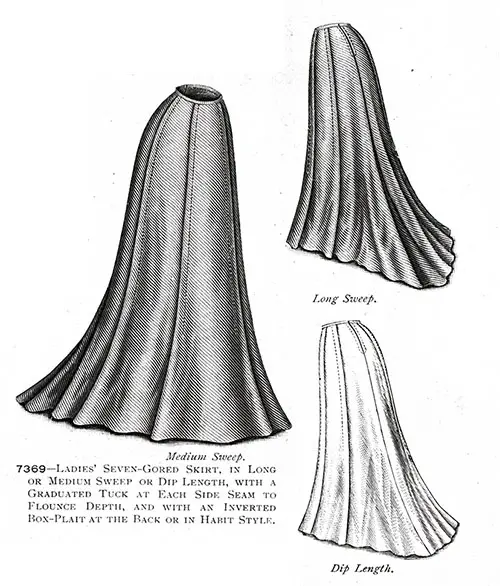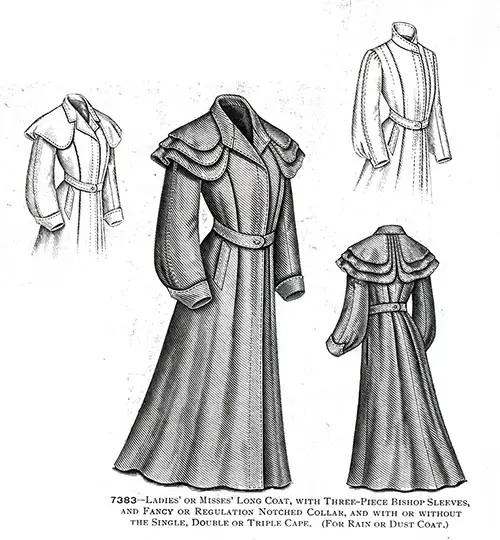Ladies and Teens Short & Long Coats - 1904

Silver braid and buttons on velour give modish decoration for this zibeline coat, reproducing No. 7410; the skirt, No. 7369, is of kersey. This useful garment develops No. 7383 in rainproof flecked gray Cheviot, with machine-stitching producing a tailored finish.

Ladies Coat No. 7410
7410—Ladies’ Coat, in Short, Three-Quarter or Long Hip Length, with Box Body and-with or without the Tab Collar.
Description of Ladies’ Coat 7410
So becoming are the box modes that their popularity shows no sign of waning. A smartly shaped coat of this order is portrayed in tan covert, finished in tailor fashion with machine-stitching and brass bullet buttons.
Under-arm and shoulder seams join the plain back and fronts, and a fly closing is employed.
A standing collar is a protective feature, and shoulder decoration is provided in the form of a cape and tab collar, the latter, however, is optional.
Bishop shaping characterizes the sleeves, one seam being used in their construction, and the wristbands support cuffs in a gauntlet style. Short three-quarter and long hip length are provided, either being fashionable.
Dressmaker Options
Black panne zibeline or black broadcloth will make a stylish coat that will give reliable service and look well with any skirt.
Reproductions are suggested in kersey, Melton, cravenette, pebble Cheviot, tweed, bear-cloth, rep granite, and heavy silks.
The decoration may be supplied with plain or fancy braid or silk facings and Persian band.
Pattern Information
Pattern 7410 is in 7 sizes from 32 to 44 inches, bust measure. For the medium size, it needs 3 5/8 yards of material 54 inches wide. Price, 20 cents.
Ladies Seven-Gored Skirt No. 7369

Ladies' Seven-Gored Skirt, in Long or Medium Sweep or Dip Length, with a Graduated Tuck at Each Side Seam to Flounce Depth, and with an Inverted Box-Plait at the Back or in Habit Style.
Description
The Ladies’ Seven-Gored Skirt is an excellent mode for a skirt to be worn with separate waists or as part of a suit is shown in brown panne zibeline without ornamentation.
Seven gores are used in its shaping, and at each side seam a graduated tuck is formed and stitched down to flounce depth, below which plaits are allowed, causing it to flare markedly at the lower edge, where a measurement of about four yards and three-fourths is reached in the medium sizes.
Provision is made for a habit back, or an inverted box-plait may take up the fulness, and the skirt may fall in alone, or medium sweep or be in dip length.
Dressmaker Options
Heavy, lusterless black taffeta is promised great favor for separate skirts to be worn with fancy waists and will make up effectively after this pattern.
Bluet kersey is suggested for wear with a jacket to correspond and a lace blouse of the same color. Melton and Cheviot are also recommended.
Pattern Information
The pattern is in sizes from 20 to 36 inches, waist measure.
For 24 inches waist or 41 inches hip measure, the skirt of 50-inch-wide fabric, without a nap or other distinct up or down, will need 4 1/8 yards; or with a nap or other distinct up or down, 5 3/8 yards in the same width.
Price, 20 cents.
Ladies’ or Teens’ Long Coat 7383

7383—Ladies’ or Misses’ Long Coat, with three-piece bishop sleeves, and fancy or regulation notched collar, and with or without the single, double, or triple cape. (for rain or dust coat.)
Description
The long coat here pictured in gray silk cravenette is desirable for fair or stormy weather, as it will repel rain or dust, and is a stylish garment as well.
Plaits from the shoulder, turned toward the center seam and stitched down to waist depth, are introduced at each side of the back, and corresponding pleats in front are stitched only to bust depth.
A fly closing is made, and the neck is finished with a fancy or a regulation notched collar. Triple capes, separated at the back, extend over the shoulders, and add to the stylish effect; one or two of these may be used if preferred, or the coat made up without them.
Upright pockets, superbly finished, are inserted in each front, and openings are allowed in the side seams through which to slip the hand in holding up the dress.
Novel sleeves of the bishop type are formed of three pieces, extra fulness being allowed below the elbow in the back and drawn into wrist extensions, cuffs being added if fancied.
Plain developments of rainproof serge, Cheviot, covert, century cloth, tweed, and frieze are recommended for storm coats, although slight ornamentation of braid is appropriate on a dust coat of silk or Sicilian.
Dressmaker Options
Dark-gray English cravenette will yield a practical reproduction of this coat, and a touch of contrast may be introduced in a collar of black velvet.
A serviceable coat for school or general wear for a young girl may be developed in navy-blue cheviot, and for extra warmth, a lining of bright-hued plaid or red flannel may be added.
Pattern Information
Pattern 7383 is in 9 sizes from 30 to 46 inches, bust measure.
For a lady of medium size, it needs 5 7/8 yards of material 54 inches wide; for a miss of 14 years or 30 inches bust measure, 4 3/4 yards in the same width will be needed.
Price, 20 cents.
“Ladies Coats [No. 7410 & 7383],” in The Delineator: An Illustrated Magazine of Literature and Fashion, Paris-London-New York-Toronto: The Butterick Publishing Co. Ltd., Vol. LXIII, No. 2, February 1904, p. 196-197, 210.
Editor's Note: Some terminology used in the description of women's clothing during the 1800s and early 1900s has been changed to reflect more modern terms. For example, a women's "Toilette" -- a form of costume or outfit has an entirely different common meaning in the 21st century. Typical terms applied to "toilette" include outfit, ensemble, or costume, depending on context.
Note: We have edited this text to correct grammatical errors and improve word choice to clarify the article for today’s readers. Changes made are typically minor, and we often left passive text “as is.” Those who need to quote the article directly should verify any changes by reviewing the original material.
